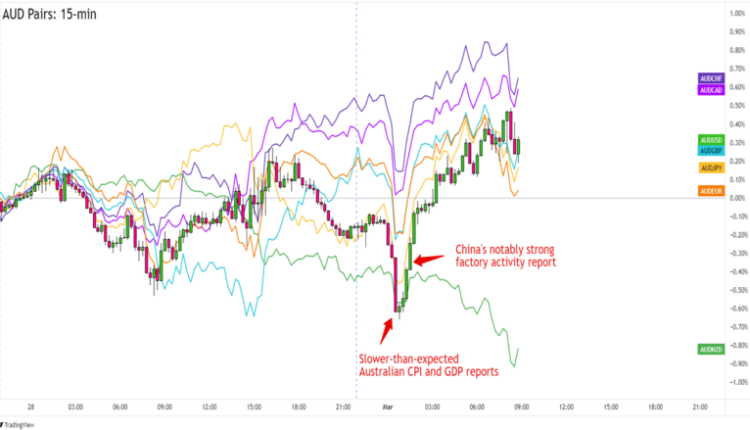Daily Forex News and Watchlist: AUD/USD
The Australian dollar suffered from slower RBA tightening expectations but China’s better-than-expected business activity reports turned things around for AUD and other risk assets.
Before moving on, ICYMI, yesterday’s watchlist watched out for further buying after GBP/USD busted above a trend line resistance. Be sure to check out if it’s still a valid play!
And now for the headlines that rocked the markets in the last trading sessions:
Fresh Market Headlines & Economic Data:
US CB consumer confidence unexpectedly fell from 106.0 to 102.9 in January on sticky inflation and high interest rate expectations
New Zealand’s building permits decline by another 1.5% m/m after a 7.2% drop in December
BRC: UK’s shop prices 8.4% higher from a year ago in February, faster than January’s 8% y/y increase and three-month average of +7.8%
Australia’s inflation up by 7.4% y/y in January, slower than December’s 8.4% growth and the expected 8.1% increase but still way above RBA’s 2-3% target range
Australia’s GDP disappoints at 0.5% q/q in Q4, less than the estimated 0.8% uptick and Q3’s upwardly revised 0.7% growth, as cost pressures and high interest rates drag household consumption to its slowest growth in five quarters
Japan’s au Jibun Bank manufacturing PMI adjusted higher from 47.4 to 47.7 in February but still lower than January’s 48.9 reading
China’s official manufacturing PMI jumped from 50.1 to 52.6 in February, the fastest expansionary pace since March 2012, after Beijing withdrew its zero-COVID policies
China’s private sector Caixin manufacturing PMI rose from 49.2 to 51.6 in February and marked its first increase since July 2022 as output and new orders saw notable increases after China lifted its zero-COVID policies
Switzerland’s retail sales grew by 0.7% y/y in January. Adjusted for inflation, sales days and holidays, real turnover fell by 2.3% compared with the previous year
Price Action News

Overlay of AUD Pairs 15-min
The Australian dollar saw a jump in volatility after China and Australia printed top-tier economic reports. Both Australia’s GDP and inflation came in lower than markets had expected.
The combination of lower inflation and lower growth dragged AUD across the board as both support slower rate hikes (if not a rate hike pause) for the Reserve Bank of Australia (RBA).
Then, China’s better-than-expected official and private sector factory activity numbers turned things around for AUD and other risk assets. The notable jumps in output and new orders highlighted the increased global demand post-COVID and fueled the start-of-month risk-taking.
AUD, which revisited Monday’s lows, made a sharp U-turn and jumped to new intraweek highs. AUD/NZD notably missed the bus, though, as traders also bought the risk-friendly NZD.
BOE Gov. Bailey to give a speech in London at 10:00 am GMT
Canada’s manufacturing PMI at 2:30 pm GMT
U.S. final manufacturing PMI at 2:45 pm GMT
U.S. ISM manufacturing PMI at 3:00 pm GMT
EIA crude oil inventories at 3:30 pm GMT
Japan’s capital spending at 11:50 pm GMT
AU building approvals at 12:30 am GMT (Mar 2)
Japan’s consumer confidence at 5:00 am GMT (Mar 2)
Use our new Currency Heat Map to quickly see a visual overview of the forex market’s price action! 🔥 🗺️
Technical Chart of the Day: AUD/USD

AUD/USD 15-minute Forex Chart by TradingView
AUD/USD was trading inside a 50-pip range all week when China’s better-than-expected business PMIs boosted risk appetite and took AUD/USD above its range support.
The pair is currently reacting to the 38.2% Fibonacci level of last week’s downswing but, unless we see new catalysts, the pro-risk environment can still extend AUD/USD’s intraday gains.
I’m keeping a closer eye on the .6800 psychological handle. Not only is it near the 50% Fib of the last downswing, it also corresponds to the height of the range that AUD/USD broke earlier today and R3 of a standard Pivot Point.
The U.S. is due to print its ISM manufacturing PMI today at 3:00 pm GMT. If the numbers support the global economic recovery tone from the Asian and early European session, AUD/USD may hit higher areas of interest like .6800.
But if today’s headlines highlight the imbalance between the economic recovery of China compared to the rest of the major economies, then we could see risk aversion that could take AUD/USD back inside its 50-pip range.


Comments are closed.